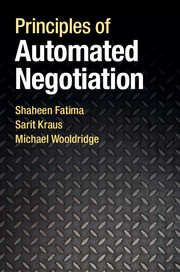Book contents
- Frontmatter
- Dedication
- Contents
- List of illustrations
- Preface
- Acknowledgements
- Summary of key notation
- 1 Introduction
- 2 Games in normal form
- 3 Games in extensive form
- 4 Negotiation domains
- 5 Strategic analysis of single-issue negotiation
- 6 Strategic analysis of multi-issue negotiation
- 7 The negotiation agenda
- 8 Multilateral negotiations
- 9 Heuristic approaches
- 10 Man–machine negotiations
- 11 Axiomatic analysis of negotiation
- 12 Applications
- 13 Related topics
- 14 Concluding remarks
- Appendix A Proofs
- References
- Index
12 - Applications
Published online by Cambridge University Press: 05 November 2014
- Frontmatter
- Dedication
- Contents
- List of illustrations
- Preface
- Acknowledgements
- Summary of key notation
- 1 Introduction
- 2 Games in normal form
- 3 Games in extensive form
- 4 Negotiation domains
- 5 Strategic analysis of single-issue negotiation
- 6 Strategic analysis of multi-issue negotiation
- 7 The negotiation agenda
- 8 Multilateral negotiations
- 9 Heuristic approaches
- 10 Man–machine negotiations
- 11 Axiomatic analysis of negotiation
- 12 Applications
- 13 Related topics
- 14 Concluding remarks
- Appendix A Proofs
- References
- Index
Summary
In this chapter we discuss a number of applications where agents can be used to negotiate on behalf of their human counterparts. In general, agents can be used for any kind of negotiation over the allocation of limited resources. For our discussion, however, we focus on the following representative cases. While some of the applications will involve direct negotiations between the parties, others will go through a trusted mediator. Also, while some will only involve software agents, others will deal with both software agents and human negotiators. Then, some applications will be for bilateral negotiations and others for multilateral ones. Finally, some will be industrial applications and others commercial ones.
12.1 Business process management
A business process is composed of a number of interdependent tasks that must be executed in a controlled and ordered way. This execution involves the consumption of resources. In most organisations, these resources are grouped into business units that control the way in which they are deployed. This is also the case with the British Telecom (BT) business process of providing a quote to a customer for installing a network to deliver a specific type of telecommunications service. For the management of this process, Jennings et al. (2000) and Norman et al. (1997) developed an agent-based negotiation framework called Adept (Advanced Decision Environment for Process Tasks).
Information
- Type
- Chapter
- Information
- Principles of Automated Negotiation , pp. 206 - 223Publisher: Cambridge University PressPrint publication year: 2014
